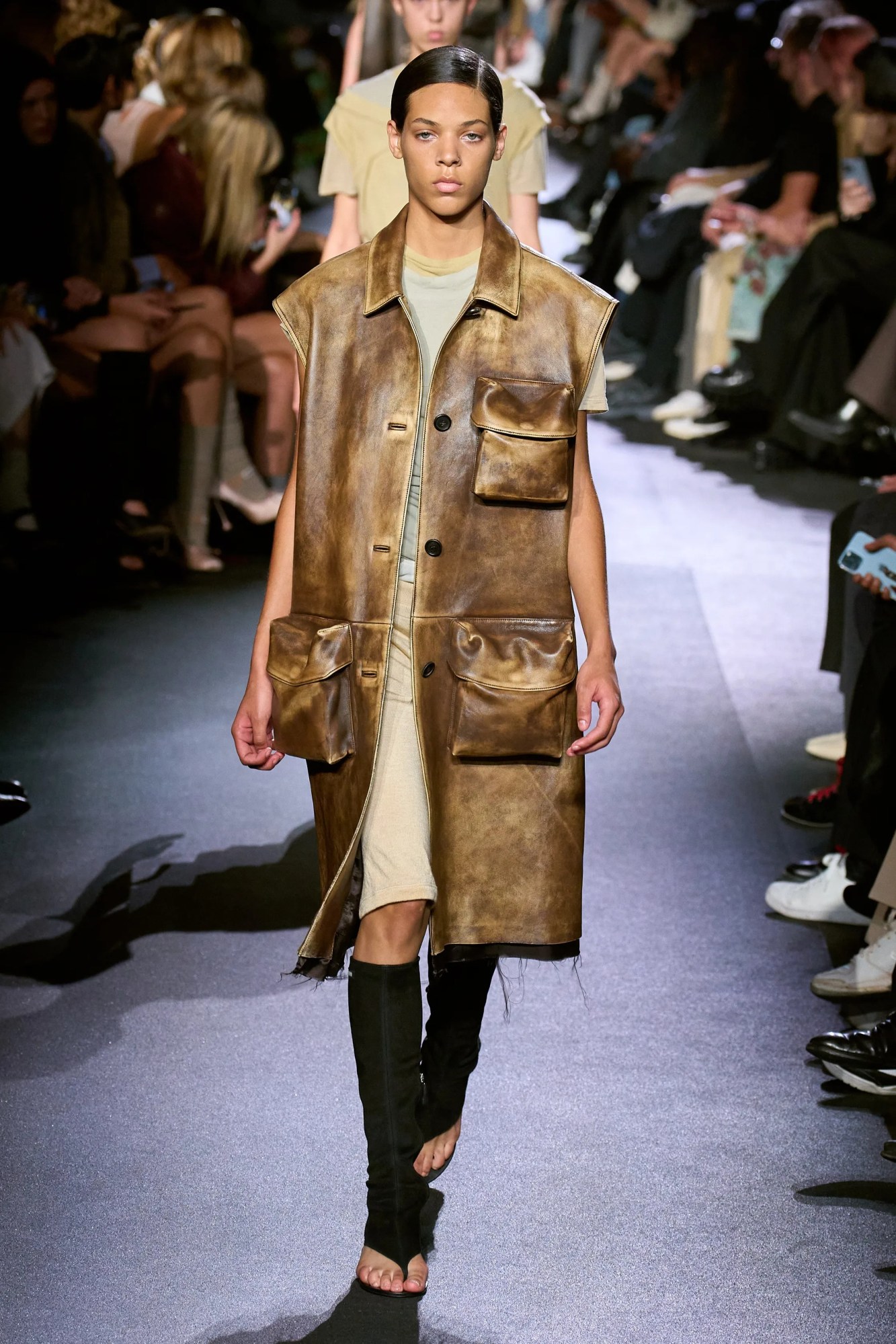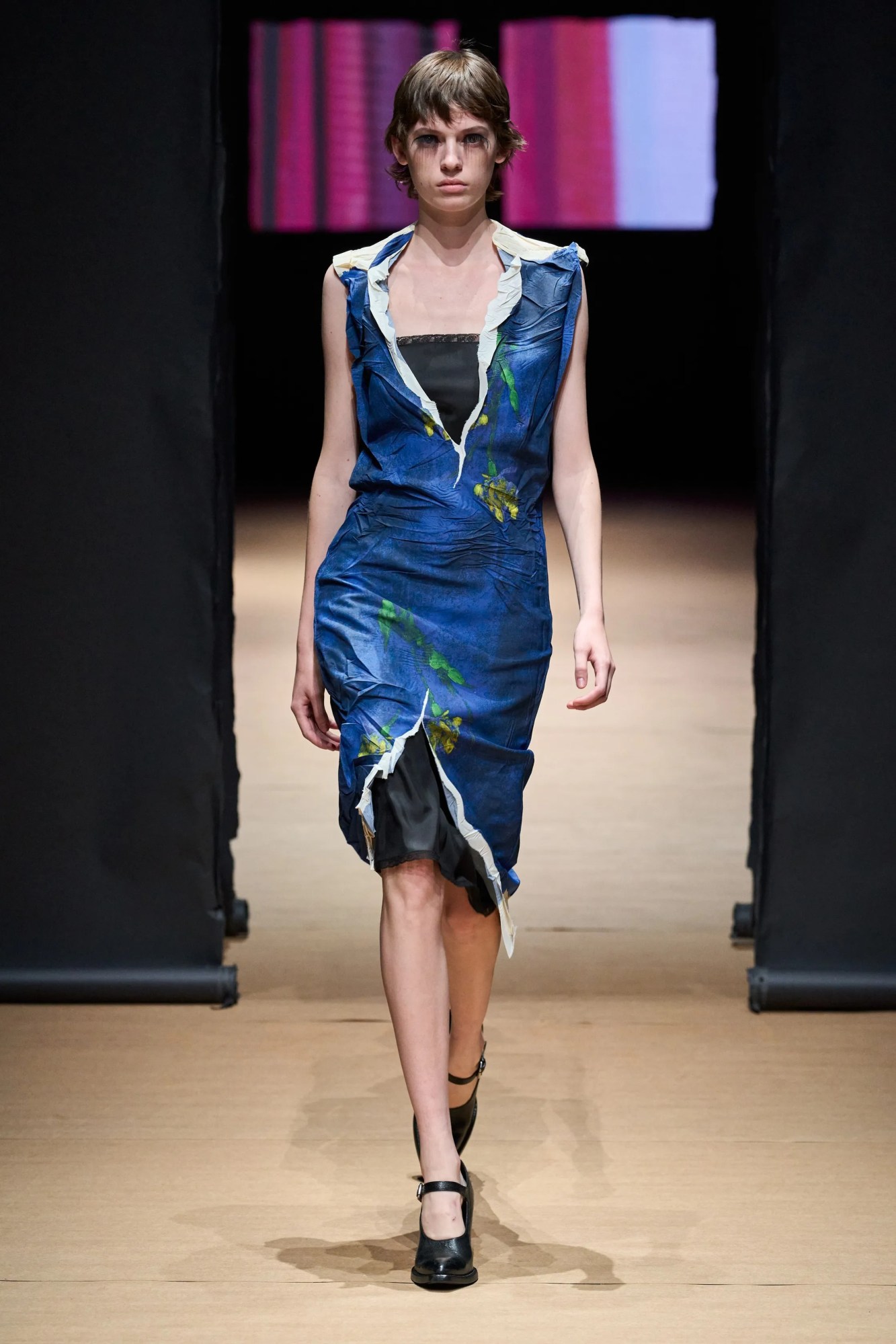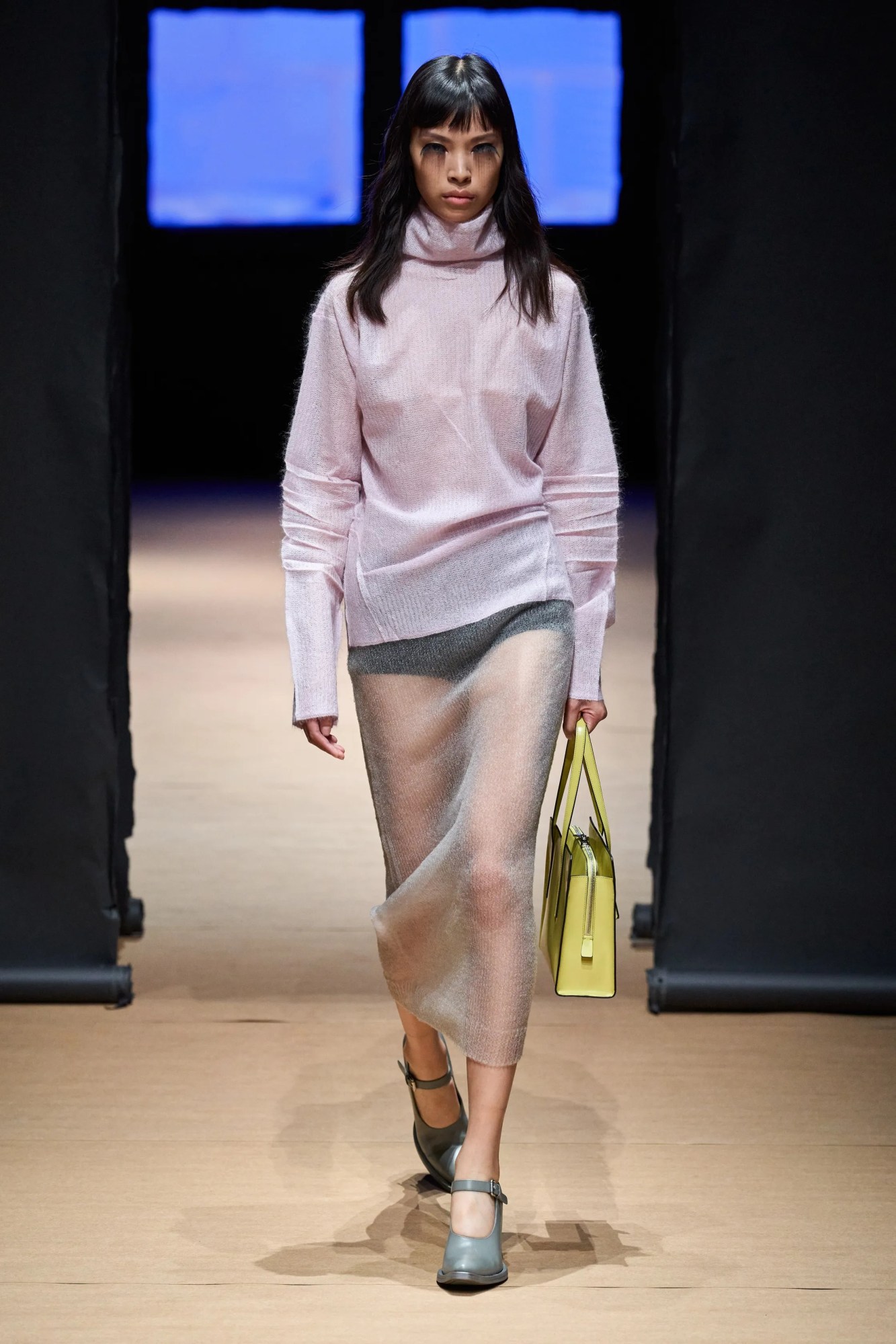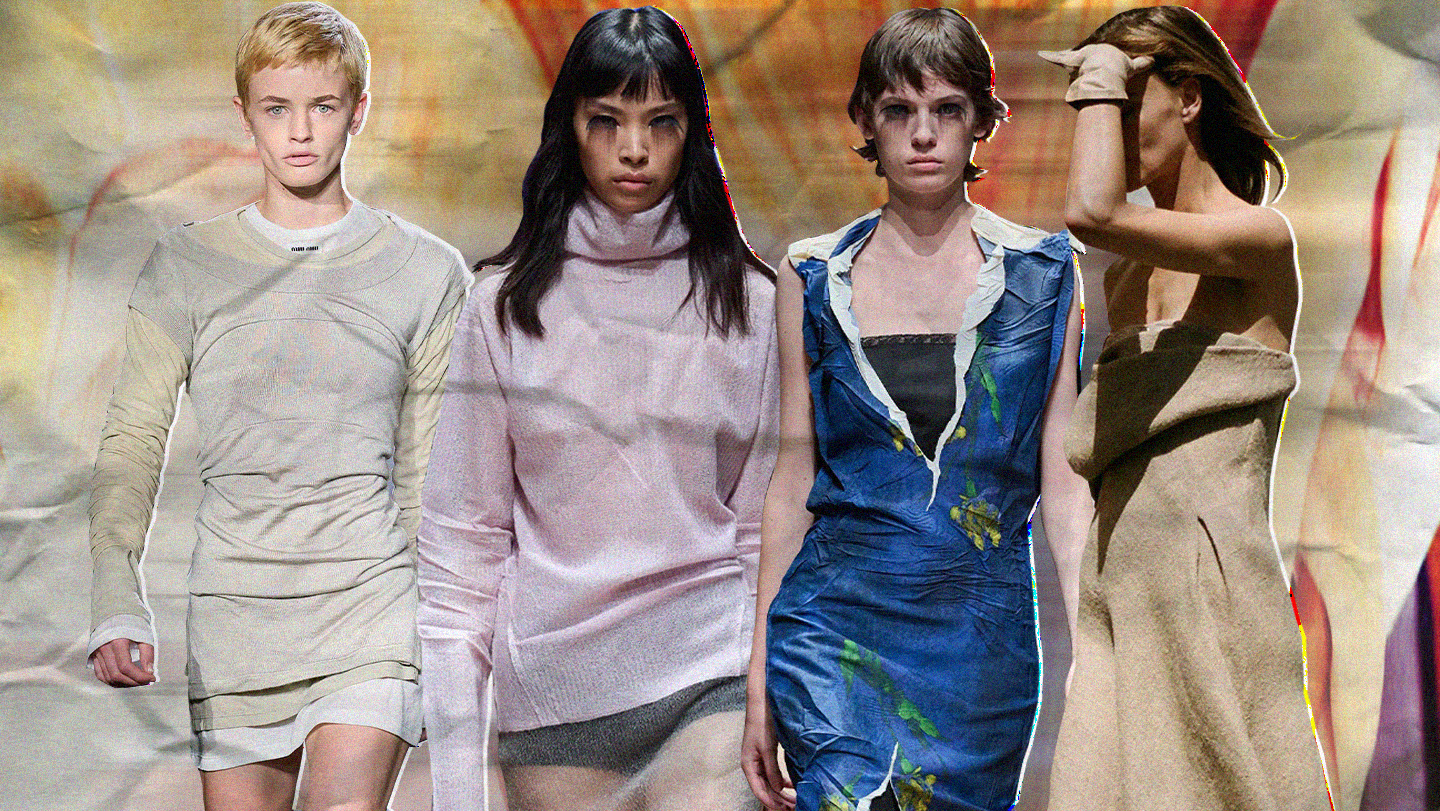At a time when many are feeling rather frayed and frazzled from the dreary state of things, fashion’s oracles held us naked and vulnerable in their gaze for SS23. Between the seemingly war-torn muddied garments of Balenciaga, the battered leathers of Miu Miu, and the creased fragility of Prada and The Row, it felt as though all our humanly imperfections were laid-out bare for everyone to see (and wear) in an aesthetic that can be best summed-up as ‘pre-worn’.
At one extreme, Demna’s collection for Balenciaga trudged us through a mud-sludged post-apocalyptic world, with inferred references to both the atrocities in Ukraine and the designer’s own personal experiences of fleeing war. But pre-worn doesn’t quite cut it in Demna’s world: several full looks of clothes, accessories and footwear were pre-destroyed via a manipulation that he has said took “a couple more days” to perfect than mint-condition luxury. The final look of the runway show, an upcycled dress made from the brand’s iconic City Bag (which is currently one of the most sought-after items on the resale market), was an angry stake in the heart of the world’s manic obsession with overconsumption. It’s a sentiment that sat strangely alongside the rest of the show, which only seemed to highlight the frivolous, perhaps disposable, nature of luxury in the face of larger world issues.

If Demna’s show was performative, then, at the other end of the pre-worn spectrum, Miuccia Prada and Raf Simons’ collection for Prada felt introspective. Here, purposefully creased skirts and knitwear were pressed in both nostalgia and fabric, while unfinished hems and necklines were neatly papered-in — a nod, perhaps, to the Japanese philosophy of wabi sabi (a world view centered on the acceptance of transience and imperfection). Mrs Prada herself has said of the collection that “life and humanity crafts the clothes – not superficial embellishment, but traces of living, leaving marks”. As it feels increasingly tiresome, and inappropriate, to continuously front an image of newness to the world, there was great relief to be found in the sentimental folds and raw edges that so frankly lauded the patina that comes with life and age.
Although we are frequently reminded that live in ‘unprecedented’ times, to poke holes in fashion, both literally and figuratively, is nothing new. In the 80s, Rei Kawakubo rebuked Western audiences with her nappy-knits, bleeding dyes, and picked-apart seams. The chef d’oeuvre of her pre-worn odyssey was a sweater from her AW82 collection, Holes, a drop-stitched knit that looked as though it had been gobbled at by starved moths (she refers to it as “Comme des Garçons lace”). The famously tight-lipped designer has never put words to her actions, but her mangled garments felt like both a criticism of the elitist, superficial veneer of the fashion institution at the time—epitomised by the high theatricality and ostentatious glamour of brands such as Mugler, Claude Montana, and Yves Saint Laurent — and a champion for the human self, in all its vulnerability and imperfection, to be re-implicated in the relationship between garment and world.

But, by the 2000s, pre-worn had become synonymous with prefabricated. As fashion historian and curator of MoMu Antwerp Elisa De Wyngaert points out in her essay Fashion’s Ambiguous Nostalgia, “The idea that you could purchase a prefabricated narrative within a garment became mainstream, as seen in the millions of identically ripped and dirtied pairs of jeans and sneakers from fast fashion brands.” And it did little to remedy “neophilia,” as J.D. Salinger called it – our insatiable desire for newness.
Clothes have become both object and subject, entangled in the great capitalistic mess of consumerism. They mediate the increasingly porous line between self and the world, between introspection and performance. Today, creative directors and designers must be so incredibly careful of the physical and moral responsibilities they assign to their clothes. Designers must capture the zeitgeist, and then more. Pre-worn cannot be just an aesthetic, it must be a modality, as was once intended by the foremother of the destroyed garment herself, Rei Kawakubo. For as Miranda Priestly so infamously warns in The Devil Wears Prada, any trend from the runway will eventually filter its way down to the discount bins of the high street.
Subscribe to i-D NEWSFLASH. A weekly newsletter delivered to your inbox on Fridays.
And this is why the aping of luxury and newness through the pre-destroyed aesthetic could be considered dangerous – or even “irresponsible.” As influencer, content creator, and Elle UK Contributing Editor Camille Charrière so poignantly presses, “we need to be teaching people to wear things in so that they look like that. That it’s okay to buy something new and for then it to look old and dishevelled with time because that’s part of the joy of having something.” To retail ostensibly ‘destroyed’ fashion objects at eye-watering prices may be a knife to the jugular of our obsession with pristine newness, but it also risks encouraging an attention-seeking attitude of wasteful wealth that the world cannot support – but that the algorithms of social media reward. We’ve seen it recently with the viral TikTok trend of people destroying Hermès Birkin bags decrying that if you’re not wealthy enough to walk all over your bag (and afford to replace it), then you’re not deserving of one.
In contrast, the strength of Prada’s collection lies in the process: creases are a map of a life-lived, a haptic negotiation between the intimacy of the body and how it moves its way through the world. In this sense, the collection encourages us to hold personal responsibility for the effect of our actions. As Camille points out, if you look at the latest Miu Miu and Prada shows, “the collections echo each other, season after season. They’re adding new pieces but keeping the pieces that have been trendy. Which I think is so encouraging because instead of wanting something new, you are like ‘this is still relevant, this is still cool, I can still wear it this year’.”
Camille, who has personally worn the latest Prada collection, remarks that “it’s like an art form in the way the garment looks on the body. It feels like a fabric that we’ve not seen before. And I think that as the garment ages, the creases will look different as well. Hopefully, it will also look beautiful in a different way.” And this is the reconsideration of luxury that we so desperately need: to place value in the ability of a garment to accrue further beauty with the creases and crumples of our lives. In a way, it’s a return to the long-forgotten adage that a rich man only has one pair of shoes – of good enough quality to last a lifetime. Or, as Elisa reminds us, to fashion at the turn of the 20th Century—before the industrial boom of ready-made garments—when value was placed on the fabric and its ability to be reconfigured with each turning trend. Textile recycling was commonplace across all echelons of society, out of both frugality and a desire to flaunt, repeatedly, the high quality of materials owned. Pride was taken in the number of wears one could wean out of a piece of fabric – the most luxurious of which were passed down between generations as a marker of familial wealth.

Lewis Bloyce, menswear buyer for Browns Fashion, similarly observes that from a commercial standpoint “there’s a change in fashion right now where customers are not as interested in stories. Customers want well-executed design. Functionality. Craftsmanship.” For him, this season’s offering from Prada, Miu, Miu, and The Row marked a move away from the obsession with full looks from single brands towards a focus on specific pieces that can be mixed and matched. “I think that this season will spur consumers to look a little closer to home. That we can get back to mixing and blending. Go raid your parents’ wardrobe. Go back to the vintage shop. Be yourself and show people what you can do.”

